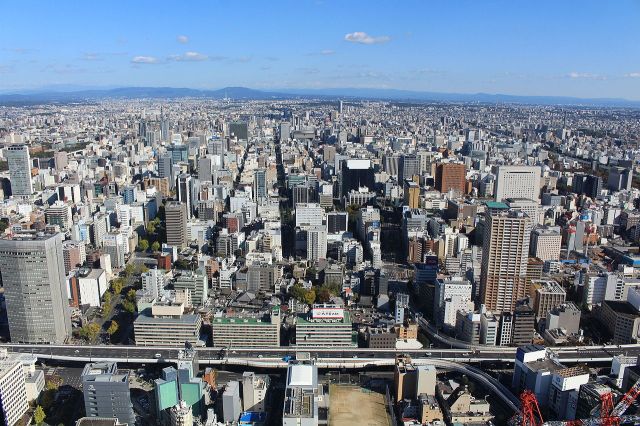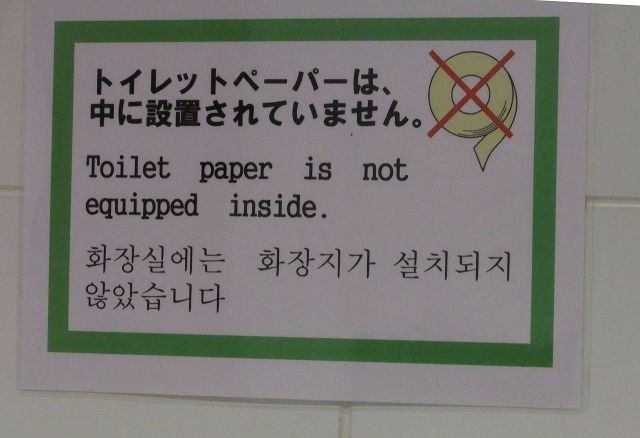
This is why it’s important to vote in city council elections.
For the second year in a row, Nagoya City was voted Japan’s “least appealing city” by a decisive margin. To be fair it was only from a field of eight major Japanese cities, so saying this result means Nagoya is a bad city is like saying a Best Picture Oscar nominee is a bad movie because it didn’t win.
▼ Maybe next year…
Still, it certainly means some self-examination is in order for city officials to find out what is making Nagoya the Hitchcock of Japanese cities. The Nagoya City Council is convening for this very reason and starting with the question: “Do you think it’s because we don’t have toilet paper in our public restrooms?”
Currently, anyone who visits one of the public toilets in Nagoya’s 600 parks, especially in haste, would be dismayed to find that no paper is provided. There aren’t even any toilet paper holders to eliminate any doubt that you just happened to enter at a bad time.
The case for toilet paper was succinctly and passionately laid out by councilman Yoshinori Matsui:
“To increase the appeal of Nagoya… To make foreign and Japanese tourists think, ‘I had a nice time visiting Nagoya…’ In the spirit of hospitality… Wouldn’t it be better to have toilet paper in the parks?”
It’s certainly hard to argue with that, but some people are. Opponents of the TP initiative are citing costs and potential for mischief as reasons and reminding all that Nagoya had flirted with public toilet paper in the past but with disastrous results. Assistant manager for the Nagoya City Environmental Works Park Maintenance Division Katsuyoshi Shimosa recalls:
“Entire rolls were thrust into toilet bowls. Sometimes they went missing altogether.”
Most would probably argue this is part and parcel for a major city in an effort to provide the most basic of comforts to residents and visitors alike. Online commenters certainly did just that as they had trouble understanding why this debate is even needed.
“Yeah, we need toilet paper.”
“Nagoya… Come on now.”
“Don’t they know there are special holders that prevent people from stealing?”
“That’s not very appealing at all.”
“Wow, I thought toilet paper was standard practice everywhere.”
“So, Nagoya is saying that they can’t use toilet paper because they can’t trust their citizens with it. That’s not appealing.”
“Why bother even having toilets if there’s no paper?”
If I may play Nagoya-advocate, one wouldn’t have to have lived so long in Japan to remember the time when a lot of public toilets all across the country didn’t have paper. Instead, you were supposed to carry your own (the packs of “pocket tissue” with ads stuffed inside that companies hand out for free on the streets of Japan were handy candidates) or buy a pack from the vending machine in restrooms which were equipped with one. In fact, it wasn’t until this decade that Osaka began righting the wrong of paperless facilities in earnest. So, Nagoya really isn’t that far behind other major cities in this regard.
▼ This sign was found in Kyoto Station circa 2010
Then there’s also the issue of the tax money required for this plan. Equipping a single toilet with paper for a year is estimated to cost about 30,000 yen (US$266) which means providing paper in all of the public parks would require an additional budget of about 25 million yen ($221,000).
Is it worth that? Yes, absolutely. But some money will have to be moved around to make it happen, especially if Nagoya decides to go all-out with its hospitality and provide round-the-clock staff who go around and fold the ends of the paper into little triangles. Now that would be appealing!
Source: Chukyo TV News, Itai News
Top image: Wikipedia/Brandon Blinkenberg
Inset image: Wikipedia/Alpsdake, Wikipedia/Gwydioin M. Williams



 She just popped up from your toilet paper to say hello!
She just popped up from your toilet paper to say hello! We travel to Fuji to see how they make Japanese toilet paper
We travel to Fuji to see how they make Japanese toilet paper Crafts for grown-ups! Make your own portable smartphone speakers with toilet paper tubes
Crafts for grown-ups! Make your own portable smartphone speakers with toilet paper tubes People in Japan are now stealing toilet paper in midst of coronavirus crisis
People in Japan are now stealing toilet paper in midst of coronavirus crisis Kyoto village dealing with poo on floor as Japanese-style toilets confuse foreign travelers
Kyoto village dealing with poo on floor as Japanese-style toilets confuse foreign travelers Hello, cosmetics! Clinique teams up with Hello Kitty this summer for first-time collaboration
Hello, cosmetics! Clinique teams up with Hello Kitty this summer for first-time collaboration Demon Slayer: Kimetsu no Yaiba gets new roller coaster attractions and food at Universal Studios Japan
Demon Slayer: Kimetsu no Yaiba gets new roller coaster attractions and food at Universal Studios Japan How to order snacks on a Shinkansen bullet train in Japan
How to order snacks on a Shinkansen bullet train in Japan High-fashion Totoro cuddle purse is like an elegant stroll in the forest【Photos】
High-fashion Totoro cuddle purse is like an elegant stroll in the forest【Photos】 Japan’s new difficult-to-drink-from beer glass protects your liver, but it’s a brutal experience
Japan’s new difficult-to-drink-from beer glass protects your liver, but it’s a brutal experience Kyoto Tower mascot termination reveals dark side behind cute Japanese characters
Kyoto Tower mascot termination reveals dark side behind cute Japanese characters Edible 10-yen coins become a hot new trend in Tokyo【Taste test】
Edible 10-yen coins become a hot new trend in Tokyo【Taste test】 Tsukiji Fish Market Vendor Releases Tuna For Home Assembly
Tsukiji Fish Market Vendor Releases Tuna For Home Assembly A visit to the best UFO catcher arcade in the universe!
A visit to the best UFO catcher arcade in the universe! New samurai glasses are Japan’s latest weird must-have souvenir
New samurai glasses are Japan’s latest weird must-have souvenir Nintendo history you can feel – Super NES, N64, and GameCube controllers become capsule toys
Nintendo history you can feel – Super NES, N64, and GameCube controllers become capsule toys “The most Delicious Cup Noodle in history” – Japan’s French Cup Noodle wins our heart【Taste test】
“The most Delicious Cup Noodle in history” – Japan’s French Cup Noodle wins our heart【Taste test】 Starbucks releases a cute Frappuccino and Unicorn Cake…but not in Japan
Starbucks releases a cute Frappuccino and Unicorn Cake…but not in Japan McDonald’s Japan’s Soft Twist Tower: A phantom ice cream only sold at select branches
McDonald’s Japan’s Soft Twist Tower: A phantom ice cream only sold at select branches Yabai Ramen: What makes this Japanese ramen so dangerous?
Yabai Ramen: What makes this Japanese ramen so dangerous? Finally! Nintendo Japan expands Switch 8-bit controller sales to everybody, Online member or not
Finally! Nintendo Japan expands Switch 8-bit controller sales to everybody, Online member or not Japanese government wants to build luxury resorts in all national parks for foreign tourists
Japanese government wants to build luxury resorts in all national parks for foreign tourists To combat declining birth rate, Japan to begin offering “Breeding Visas” to foreigners
To combat declining birth rate, Japan to begin offering “Breeding Visas” to foreigners 10 things you should buy at 7-Eleven in Japan
10 things you should buy at 7-Eleven in Japan Studio Ghibli releases anime heroine cosplay dresses that are super comfy to wear
Studio Ghibli releases anime heroine cosplay dresses that are super comfy to wear Woman charged for driving suitcase without a license in Osaka
Woman charged for driving suitcase without a license in Osaka Studio Ghibli unveils My Neighbour Totoro miniature house model
Studio Ghibli unveils My Neighbour Totoro miniature house model Kyoto experiencing problems with foreign tourists not paying for bus fares, but not on purpose
Kyoto experiencing problems with foreign tourists not paying for bus fares, but not on purpose Fighting mild hunger with a Japanese soda that turns into jelly in the stomach【Taste test】
Fighting mild hunger with a Japanese soda that turns into jelly in the stomach【Taste test】 Studio Ghibli’s Howl’s Moving Castle tapestry unveiled in Japan for first time
Studio Ghibli’s Howl’s Moving Castle tapestry unveiled in Japan for first time McDonald’s new Happy Meals offer up cute and practical Sanrio lifestyle goods
McDonald’s new Happy Meals offer up cute and practical Sanrio lifestyle goods Sales of Japan’s most convenient train ticket/shopping payment cards suspended indefinitely
Sales of Japan’s most convenient train ticket/shopping payment cards suspended indefinitely Sold-out Studio Ghibli desktop humidifiers are back so Totoro can help you through the dry season
Sold-out Studio Ghibli desktop humidifiers are back so Totoro can help you through the dry season Japanese government to make first change to romanization spelling rules since the 1950s
Japanese government to make first change to romanization spelling rules since the 1950s Foreigner’s request for help in Tokyo makes us sad for the state of society
Foreigner’s request for help in Tokyo makes us sad for the state of society Ghibli founders Toshio Suzuki and Hayao Miyazaki contribute to Japanese whisky Totoro label design
Ghibli founders Toshio Suzuki and Hayao Miyazaki contribute to Japanese whisky Totoro label design Doraemon found buried at sea as scene from 1993 anime becomes real life【Photos】
Doraemon found buried at sea as scene from 1993 anime becomes real life【Photos】 Tokyo’s most famous Starbucks is closed
Tokyo’s most famous Starbucks is closed Princesses, fruits, and blacksmiths: Study reveals the 30 most unusual family names in Japan
Princesses, fruits, and blacksmiths: Study reveals the 30 most unusual family names in Japan Aichi police on lookout for scoundrel who stole public toilet’s flushing handle
Aichi police on lookout for scoundrel who stole public toilet’s flushing handle Japanese truck driver arrested for slapping young boy in the face after wet toilet paper prank
Japanese truck driver arrested for slapping young boy in the face after wet toilet paper prank Japanese store curses toilet paper supply to protect it from thefts
Japanese store curses toilet paper supply to protect it from thefts Japanese politicians want to make walking while looking at your smartphone illegal
Japanese politicians want to make walking while looking at your smartphone illegal Japanese squat toilet plastic model kit: Weird, gross, or both?【Photos】
Japanese squat toilet plastic model kit: Weird, gross, or both?【Photos】 New Japanese toilet paper dispenser tears off sheets, folds the ends into a point for you【Video】
New Japanese toilet paper dispenser tears off sheets, folds the ends into a point for you【Video】 Squat toilets’ popularity fading as parents call for them to be abolished in Japanese schools
Squat toilets’ popularity fading as parents call for them to be abolished in Japanese schools Japanese arcade restroom asks customers to declare loyalty for dogs or cats in toilet paper poll
Japanese arcade restroom asks customers to declare loyalty for dogs or cats in toilet paper poll Flush your prayers down the toilet at this unique Japanese temple
Flush your prayers down the toilet at this unique Japanese temple Japanese mayor who bit athlete’s gold medal tests positive for coronavirus
Japanese mayor who bit athlete’s gold medal tests positive for coronavirus City official, angered when asked to wear a mask, throws own feces
City official, angered when asked to wear a mask, throws own feces Japanese city’s plan to make convenience store restrooms public restrooms stinks, owners think
Japanese city’s plan to make convenience store restrooms public restrooms stinks, owners think Use this Japanese-style toilet properly, or else “you are gonna fall down on s***”
Use this Japanese-style toilet properly, or else “you are gonna fall down on s***” Bathroom in Japan has ladies vote for the boyfriend they prefer by the toilet paper roll they use
Bathroom in Japan has ladies vote for the boyfriend they prefer by the toilet paper roll they use Japanese politicians boycott meetings for being told they should wear ties when they didn’t have to
Japanese politicians boycott meetings for being told they should wear ties when they didn’t have to
Leave a Reply